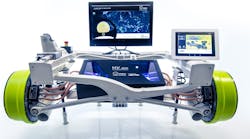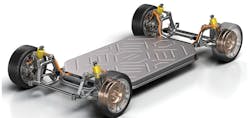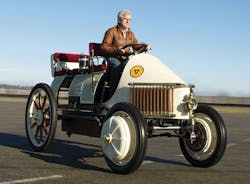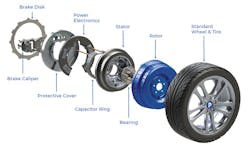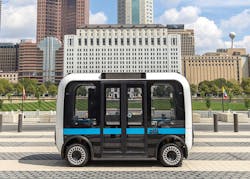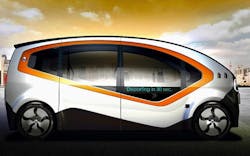New in-wheel motor systems modify the hub of each electric-vehicle (EV) wheel by adding a complete drivetrain that supplies torque to its associated tire (Fig. 1). Also included with these in-wheel motor systems are braking components and the motor-drive electronics. Road tests will demonstrate in-wheel motor system performance and durability, which will ultimately impact EV performance.
1. Mounting the motors outboard creates additional room on the chassis for passengers or cargo.
At present, it appears that in-wheel motors can provide advantages in several areas. Conventional vehicles implement functions like traction and stability control by slowing down the wheel that’s spinning faster than it should. But that approach is rather slow to respond and is limited to applying retarding force. To unlock a skidding tire, it would be preferable to apply some driving torque. With in-wheel motors, you can do that. You can deliver precisely controlled braking or motoring torque on a millisecond timescale and thereby greatly improve traction and stability control, reducing stopping distances and enhancing drivability and safety.
In-wheel motors also allow torque vectoring—the application of different torques to different wheels that can markedly improve handling. In a car with an in-wheel motor system, this hardware ability comes essentially free, requiring only the right software. The result can be a vehicle than corners as if on rails; one that can feel both nimble in city traffic and stable at high speeds.
In-Wheel Evolution
Actually, the basic in-wheel motor technology dates back to the end of the 19th century, when Ferdinand Porsche (of the present company) in Vienna and Joseph Ledwinka and Fred Newman in Chicago attached an electric motor to each wheel of a horseless carriage to provide power simply, efficiently, and controllably (Fig. 2). Their rudimentary design didn’t have the sophistication of current in-wheel motor techniques.
2. Shown is a reconstructed version of the turn-of-the-20th-century Lohner-Porsche Semper Vivus with its two in-wheel electric motors in the front.
Today’s in-wheel technology developers, such as Protean Electric, claim they have overcome or are close to overcoming the challenges of using these motors: cost, additional mass, and road shocks. Motor-control software is also a key design challenge. It must make decisions about what torque to demand from each motor at each instant, based on the vehicle’s condition and the driver’s commands.
Under normal circumstances, running two motors instead of just one is straightforward. But if a fault occurs in one motor, the controller needs to prevent a dangerous asymmetry from developing, which would cause the vehicle to be pulled to one side in an uncontrollable way.
Protean Electric’s response to this safety issue was to include two completely independent systems that can detect a fault and equalize torque across two or more motors. Vehicles must meet ISO 26262, a safety standard that calls for proving that a hazardous technical failure will be extraordinarily unlikely. It’s an extremely difficult standard to satisfy, but Protean is confident that its motors will support carmakers in complying with these requirements.
Protean’s motors fit behind the wheels of a vehicle, so they can be used as part of a drive system that doesn’t require a gearbox, differential, or drive shafts. This creates an energy-efficient drivetrain that potentially saves cost, reduces weight, and frees up space on board the vehicle that was previously dedicated to drivetrain components. According to Protean Electric, its in-wheel motors can increase fuel economy by over 30%, depending on the battery size and driving cycle in a hybrid or plug-in hybrid vehicle. It is also capable of enabling torque vectoring by applying individual torque at optimal levels to each wheel to improve vehicle safety and handling.
In-wheel motors still have two challenges to overcome:
- Reducing unsprung mass because the weight of a motor will be carried in each powered wheel.
- Protecting against road shocks and heat from braking due to the proximity of the in-wheel motor to the wheels.
Wrangling with Unsprung Mass
In-wheel motors add unsprung weight, which is the enemy of handling. Every time the car hits a bump, a pothole, or a speed bump, all that weight has to get started in one direction and then move in the opposite direction as soon as the spring that it’s attached to reaches the limit of its travel.
Unsprung mass is everything between a car’s suspension system and the road. In a conventional vehicle, this includes brakes, bearings, wheels, constant-velocity joints (the devices on the ends of the drive axles that let them transmit power at an angle), and tires. Keeping unsprung mass to a minimum is a good thing. Reducing it improves ride quality for the driver and passengers, and makes it easier for the suspension to keep the tires in contact with the road.
To deal with unsprung maas, Protean went to England-based Lotus Engineering, a recognized expert in ride and handling, and asked its engineers to investigate objectively the effects of unsprung mass on vehicle handling. Lotus added a mass of up to 30 kilograms to each of the four wheels of a Ford Focus and instrumented the car to measure vibration and movement.
Its work was supported with computer simulations to gain a deeper understanding of the effects of adding both static and rotating mass to the wheels. Furthermore, trained drivers performed standardized assessments to provide additional information about how the added mass affected ride and handling.
Lotus found that the impact of increased unsprung mass, though noticeable to a trained driver, was really not all that significant. The added mass made the car feel as though its suspension and steering hadn’t yet undergone the usual tuning activities that are a standard part of vehicle development.
The Lotus engineers were able to eliminate much of the effect of the added unsprung mass by using slightly more suspension damping. What’s more, they found that when that unsprung mass came from actual motors attached to the wheels, the ability to power each side of the car independently improved the car’s handling substantially.
ProteanDrive
Protean’s latest in-wheel motor system, called ProteanDrive, is a complete drivetrain in the wheel. There are no gears or transmission. Instead, the rotor of the electric motor connects directly to the hub, delivering torque from the motor to the wheel. This helps maximize efficiency and compactness (Fig. 3).
3. The Protean Electric Pd18 fits in an 18-in. (46 cm) wheel rim. The motor can generate up to 75 kW, or just over 100 hp, for each powered wheel.
The Pd18, Protean’s flagship product, is designed to fit in an 18-in.-diameter (about 46 cm) wheel rim. The Pd18, which weighs 36 kilograms (79 pounds), can deliver 1,250 newton meters (Nm), or 922 foot-pounds, of torque and 75 kW of power at the wheel. That means two of them could offer up to 2,500 Nm of torque and 150 kW of power.
This might seem an inordinately large amount of torque, considering that a typical internal-combustion car engine can produce only a few hundred newton meters. But, in a conventional car, the engine torque is multiplied by whatever the gear ratio is between the engine and the wheels. In first gear, that might be a number like 10; in higher gears, the multiplier would be lower. Therefore, a pair of Pd18s can match the typical level of wheel torque provided by a conventional car.
At the core of the ProteanDrive is a permanent-magnet synchronous motor and a set of tightly integrated electronics. The electronics send precisely controlled current into the motor’s windings, creating magnetic fields that interact with the rare-earth permanent magnets affixed to the rotor. Thus, each in-wheel motor can deliver the required amount of torque in as little as a millisecond.
Electronic circuits within the overall motor package shares cooling with the motor, whose windings may carry up to 90 A, so they dissipate waste heat. That heat, along with the heat from the electronics, is carried off by water flowing through a coolant channel in the motor housing. The coolant is in good thermal contact with both the electronic components and the motor windings. Those windings are encapsulated in a protective epoxy resin, which helps to conduct heat away. Close integration of the motor and drive electronics enables a very small motor to generate a great deal of power.
Software, running on a microprocessor supported by a field-programmable gate array, makes 16,000 decisions per second on what voltages should be applied to the windings. They’re based on measurements from sensors that deliver information on the electrical and thermal condition of the motor, as well as its position and speed. The software ensures that the current flowing through the motor is exactly right for smooth, quiet operation.
Because the motor requires no transmission or differential or constant-velocity (CV) joints to connect with the wheels, it loses far less energy to friction. Thus, it can use a smaller battery to deliver the same range, resulting in significant savings. It also promises to reduce operating costs, as any car owner who has had to replace a torn CV boot will appreciate.
To achieve all of this, Protean had to overcome several technical challenges. One was miniaturizing and integrating the inverter. Most inverters for vehicular applications are the size of a large shoebox. Protean’s version is packaged into less than half that space, so that it can fit neatly behind the electric motor. By packaging things in this manner, just two dc cables are needed for each motor. If the inverter been mounted elsewhere, it would have required sending ac over as many as six cables.
Protean’s motor is configured with the rotor on the outside. This places the gap between the stator and the rotor (across which the magnetic forces are developed) at the maximum radius available, thereby creating as much torque as possible within the confines of the wheel rim. Such an approach lets the motor develop sufficient torque without the need for gearing, which would have lowered efficiency and generated noise.
Environment Effects
The in-wheel system must withstand the various environmental conditions a wheel might experience over the lifetime of a vehicle—e.g., shock, vibration, water, and rocks. When the driver demands power from the vehicle, the electronics rapidly become hot and then later cool down; this repeated thermal cycling can lead to premature degradation of the components.
Protean used special rigs to test the electronics and identify weak points. The engineering team now has what they feel is a very robust design, one that will last the lifetime of the vehicle. The company defines lifetime as 300,000 km, 15 years, and 8,000 operating hours—these being the general expectations of this very demanding industry.
No matter how unique the technology, its cost could be prohibitive. Protean compared the cost of a typical electric drivetrain, one with a gearbox, motor, differential, and driveshaft, with that of two in-wheel motors. Although two motors are somewhat more expensive than one central motor and drivetrain, the in-wheel system is more efficient because it has a lower mass and doesn’t suffer from frictional losses in the transmission. Therefore, in many cases, the carmaker can deliver a vehicle that goes faster or farther (or both) while costing no more than competing models.
Another concern about in-wheel motors is their supposed lack of durability. Placing the motors in the wheels, as opposed to under the hood, means they will get battered when the car travels over rough roads. They’ll also be pelted by water, sand, gravel, and all of the other detritus we drive over on a regular basis. These conditions could pose a problem, but Protean’s testing has shown it’s possible to engineer a product that can hold up to the beating.
4. Protean Electric’s strategic partnership with LM Industries will provide in-wheel motors for that company’s autonomous passenger shuttle, dubbed “Olli.”
Protean and U.S. open-source vehicle designer LM Industries partnered to provide the in-wheel technology for Olli—the world’s first co-created, self-driving, electric and cognitive shuttle (Fig. 4).
The Fisker Orbit autonomous electric shuttle will use in-wheel motor technology for improved interior space (Fig. 5). The in-wheel technology is that of Protean Electric.
5. In-wheel motors are used in the Fisker Orbit, an autonomous shuttle bus.
Competition
Slovenian company Elaphe is also making in-wheel technology for application in electric vehicles (Fig. 6). Elaphe has tested its fully electric in-wheel drive on a frozen river in China at temperatures of below −30°C (−22°F) to prove that traction control on ice is better than in ICE cars
German company Ziehl-Abegg created a motor for an in-wheel hub drive that could be used in serial hybrid, battery, and fuel-cell commercial vehicles.
And Nissan has developed in-wheel motors for the BladeGlider—a working prototype of its futuristic concept car.
